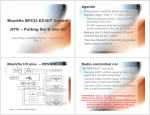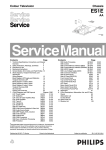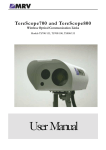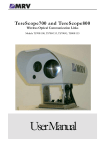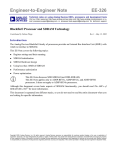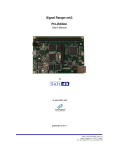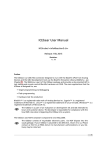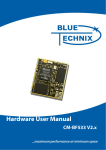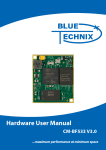Download 15-09-25T_Lab1_Lec2_ActivateLEDs-2
Transcript
Agenda
• Processors need to send out control
signals (high / low 1 / 0 true / false)
Blackfin BF533 EZ-KIT Control
– General purpose input / output GPIO on
processor chip (16)
– FLASH memory chip has additional I/O
ports connected to Ez-Lite KIT LED’s
Putting the O into I/O
(JITK – Just In Time Knowledge)
• Making the FLASH memory I/O port
control the Ez-KIT LED’s
• The new Blackfin assembly language
instructions needed
Activating a FLASH memory “output line”
Part 2
The ROW and RAW ideas are the same as in Lab. 0,
Assignment 1, Lab. 2, Lab. 3 and Lab. 4
Blackfin BF533 I/O
Blackfin I/O pins -- REVIEW
2
Radio controlled car -- REVIEW
“IN PRINCIPLE”, we could
• Connect LED1 control signal to turn right
signal line of radio transmitter
• Connect LED2 control signal to forward
signal line of radio transmitter
• Connect LED3 control signal to left signal
line of radio transmitter
“IN PRINCIPLE” means – we might start off this way while we
initially explore ideas to control the car.
However we may (or may not) finish the project a different way.
– In actually fact we will use both PF1, PF5, PF6, PF7 as output to control
car during the labs. IN PRINCIPLE – During Lab 4 we could use SPI
interface so we can control car and put out messages to operator on
LCD screen. (Same SPI as used during TV flashing ship lab.)
Blackfin BF533 I/O
3
Blackfin BF533 I/O
4
LEDs connected to memory port
REVIEW
RIGHT
• Get the FLASH to work correctly
FORWARD
LEFT
BACK / DONE
POWER ON
– Performed by InitFlash_CPP( ) function
• Get the Port to work correctly as output for
pins PB5 PB0, leaving other pins
unchanged in behaviour
These pins
might be
connected to
other things
– Performed by InitFlashPort_CPP( ) function
DON’T CHANGE
THEIR
BEHAVIOUR
• Write the value we want to LEDs
– WriteFlashLED_ASM(int value) or
– WriteFlashLED_CPP( int value) or both
• Read back the value the LEDs show
– int ReadFlashLED_ASM(void) or
– int ReadFlashLED_CPP(void) or both
Blackfin BF533 I/O
5
“EBIU” External Bus Interface
Unit -- REVIEW
FLASH
SDRAM
6
ASK ME ABOUT
W , B and (Z)
• McVASH and COFFEE
control logic ideas again!
• LDF file controlled
• If P0 (pointer
register) is set to
address 0x20001000
then
R0 = W[P0] (Z);
reads a 32-bit value
from FLASH BANK 0
J.I.T.K .-- Just-In-Time-Knowledge – Need to W.A.I.N. rather than W.A.I.L.
Blackfin BF533 I/O
Blackfin BF533 I/O
ANSWER -- Blackfin Memory Map
How does EBIU “know” whether to execute your code
by writing the data to FLASH (LEDs live there) or
SDRAM memory (Large arrays live there)?
•
CHANGE INTERFACING FROM ASM TO CPP CODE
Activating LEDs -- REVIEW
• If R0 is 6 and
P0 is 0x0000 1000
then
B[P0] = R0;
places an 8-bit value into
SDRAM memory
7
Blackfin BF533 I/O
8
FLASH registers -- REVIEW
Bank control register -- REVIEW
How does Blackfin “match” itself for
fastest FLASH operation
Reset value will probably work “as is” but
not efficient – “slow reads”
– Efficiency not normally a problem – if op not done often
Blackfin BF533 I/O
9
Blackfin BF533 I/O
General Control Register -- REVIEW
InitFlashCPP( ) -- REVIEW
• Reset value leaves “CLKOUT”
disabled – is that important?
• Get the FLASH to work correctly
• May be “many” processes running on the
Blackfin. All these processes may want to use
InitFlashCPP( )
Blackfin BF533 I/O
11
InitFlashCPP( ) { // Design ideas by pseudo code
If FLASH memory is already configured
– return without re-initializing
to avoid destroying existing code
Else {
configure Memory Bank control register
THEN configure Global control
(turns on the FLASH)
}
}
Blackfin BF533 I/O
10
CHANGE INTERFACING FROM ASM TO CPP CODE
• Depends on which FLASH is used in the
EZ-Lite KIT from a specific manufacturer!
12
I looked in EZ-Kit online documentation
Set the Bank control register
• Don’t start from scratch – Look for
recommended settings
• These settings are specific for FLASH
memory used on the EZ-Kit Lite
board
• Kit documentation recommends 0x7BB0.
P.L1.Q -- What does this setting mean?
PERIPHERAL REGISTER ADDRESS
PERIPHERAL REGISTER RESET VALUE
7 cycles
not 15
IGNORE
11 not 15
B = 1011
2 cycles
Turns on clock
4
cycles
3 cycles
Blackfin BF533 I/O
13
Blackfin BF533 I/O
14
Set General Control Register
Control access speed -- REVIEW
• Documentation says set to “0x000F”
for this particular FLASH chip
PERIPHERAL REGISTER RESET VALUE
0 000 00 0 0 0000 11 11
ENABLE
Note: We don’t access this memory
location using an pointer register (P0)
with value 0xFFC0 0A00
.
Instead we #include <blackfin.h> in
our code and use a pointer value
EBIU_AMGTCL (Software engineering
abstraction concept)
Blackfin BF533 I/O
15
USE ALL
Blackfin BF533 I/O
CODING BIT VALUE 001 IS EASY 0x01
ASK ME -- HOW DO YOU CODE 1XX?
WHILE X MEANS ‘DON’T CARE – THE
PROCESSOR CARES – WHICH
REQUIRES YOU MAKE A DECISION!!!!
PERIPHERAL REGISTER ADDRESS
16
Does not sound too big a deal (IN PRINCIPLE)
•
1. Set pointer to EBIU_AMBCTLO address
2. Then set value = 0x7BB07BB0
3. Then store value at EBIU_AMBCTLO
*pt = value (Real C++ code or ASM design comment)
4. Then make sure “write occurs” NOW as this processor can
delay doing writes “until convenient”.
This processor is DESIGNED to do “writes” when
“it is not busy” giving highest priority to MANY read
operations. This priority scheme is useful when
developing processing algorithms for video or audio.
Do the same for the other “32
bit”
FLASH
registers
Blackfin
BF533
I/O
17
When stub is tested as a stub (Link and
Run) then add ASM code to learn format
If I asked in
quiz – Circle
and explain
the defects
already in
code? Are they
compiler,
linker, loader
or run
defects?
ERROR WHEN WRITING ASM CODE
AVOID SAME PROBLEM IN C++
CHANGED TO use uTTCOS_InitLED( )
Show and tell – you are not actually going to code this for Lab. 1
Call uTTCOS utility instead -- uTTCOS_InitLED( );
Asking you about the ideas or doing some of the code
makes a good quiz or exam question
Blackfin BF533 I/O
Obvious problem – value needed
EBIU_AMBCTL0 = ?
• LOOK IN THE MANUAL – CHAPTER 17
QUIZ
QUESTION
Code review
Is the following the equivalent define to use in C++
#define pBIU_AMBCTL0 = (int *) 0xFFC0 0A04
(If use #include
NEW VIP BLACKFIN
INSTRUCTION SSYNC;
2 more
obvious
errors
FIND AND
EXPLAIN
THEM
Finish all pipelined operations
before continuing
Blackfin BF533 I/O
18
19
Blackfin BF533 I/O
CHANGE INTERFACING FROM ASM TO CPP CODE
InitFlashCPP( )
CHANGE INTERFACING FROM ASM TO CPP CODE
Build and Test Stub -- REVIEW
CHANGE INTERFACING FROM ASM TO CPP CODE
Key issues -- REVIEW
20
MIPS and Blackfin behave same when
putting 32 bit numbers into 32 bit
registers
• You can’t load a 32-bit register with a 32bit immediate value using one instruction
• WRONG R0 = 0x7BB07BB0;
• Must load low 16-bit of data register
R0.L = 0x7BB0;
• Then load high 16-bits of data register
R0.H = 0x7B00;
No “=“ in a define
statement
No “spaces” in
number
PSP Don’t make
the same errors
When you code
in Lab. 1 or when
you write
Quiz 1
Spell check
“0” not “O”
DEFECTS in code
process
•
Pair programming
cost if not caught
by partner
In C++ code, a similar error is coding
unsigned int value (32 bits)
when you meant to use unsigned short value (16 bits)
3 * $5
Blackfin BF533 I/O
21
More readable and reliable
ASM code example
Use twice
(with no defects)
Self documenting
code
I do “define”
and then use
(double-click)
cut-and-paste
the label
(AMA -- double-click)
CHANGE INTERFACING FROM ASM TO CPP CODE
YOU FIX THIS CODE
Blackfin BF533 I/O
Blackfin BF533 I/O
22
What to look for in the following slides
PSP from carpentry
#define ONCE correctly
You must load addresses into pointer register P0 the same
way. YOU write the code to replace P0 = 0xFFC00A04
CHANGE INTERFACING FROM ASM TO CPP CODE
Corrected code – still fails
(Get equivalent errors in C++)
23
Detailed look at the WriteLED( ) and
ReadLED( ) code you will USE
(rather than write) during the
familiarization laboratory and Lab. 1
• Look at how the Blackfin assembly
language syntax is used.
• KEY ELEMENT TO USE IN LABS AND
QUIZZES.
– Must do our coding without destroying the
operation of existing code functionality.
– When using hardware, this normally means the
extensive use of bitwise AND and OR
operations. Those RAW’s and ROW’s again
Blackfin BF533 I/O
24
USER CASE STUDY – TASK -- Write ‘1’
(on) or ‘0’ (off) to the Port to activate
LEDs connected to pins PB5 PB0,
leaving other pins unchanged.
Blackfin BF533 I/O
WriteFlashLEDASM(long in_Value)
PROGRAMMED IN ASSEMBLY CODE
WriteFlashLEDASM(long inValue)
25
1. Read “8-bit LED data register” into 32-bit processor data
register R1 (makes a copy)
2. Keep “top” 2 bits (AND operation on bits 7 and 6) of the copied
value in R1 as they have been made 1 or 0 for a reason
3. Keep “bottom” 6 bits of “in-par” 32-bit in_value (R0)
4. OR the two processor data registers
5. Write “modified copy” back into 8-bit “LED data register”
• PROBLEM “byte” read and writes – how do we do
those?
Blackfin BF533 I/O
26
Standard ENCM369 assembly code
problem, but using different syntax
• Start with the stub and pseudo-code of
user-case study
The following way of writing assembly
code is from my P. S. P.
– Use the ‘real C++’ as psuedo-code when we
know what to. Use a description otherwise
I find it speeds coding up as I make
less mistakes
Typo bottom6bitmask
Blackfin BF533 I/O
27
Blackfin BF533 I/O
28
Now identify the registers to use
Add in the code we understand
• Input value (In_par) come in R0
• We can use R1, R2 and R3 without saving
(Follows C++ / ASM coding convention)
Look for hidden defects where code does not match comments
Fixed typo
Still another
syntax
problem
8 bit and 32 bit writes
(Chapter 6 of instruction user manual?)
• [P0] = R0;
32-bit write (4 bytes)
– Places all 32-bits of processor data
register into “long word” (32 bit)
address starting at memory location P0
– If P0 = 0x1000 – then place “32-bit” value
at memory location 0x1000
• B[P0] = R0;
8-bit write
– Places “bottom” 8-bits of 32-bit
processor data register into “byte” (8
bit) address starting at memory location
pointed to by pointer register P0
Blackfin BF533 I/O
29
31
Blackfin BF533 I/O
8 bit and 32 bit reads
• R0 = [P0];
32-bit read (4 bytes)
– Places all 32-bits of “long word” (32 bit)
address starting at memory location P0
into processor data register
– If P0 = 0x1000 – then place “32-bit” value
at memory location 0x1000
• R0 = B[P0] (Z);
8-bit read
– Places “byte” (8 bit) address starting at
memory location P0 into “bottom” 8-bits
of processor data register and puts “0”
into the “top” 24 bits of register
– Must convert “8-bit” read operation into
a “32” bit “store in register” operation
Blackfin BF533 I/O
30
COMMON MIS-UNDERSTANDING -- You need a 32-bit (not
8-bit) address register read a 8 bit data value (because
memory is large and so you need a large address to acces)
Typo bottom6bitmask
(defect if not spotted)
COMMON MIS-UNDERSTANDING -- You need a 32-bit (not
8-bit) address register to write a 8 bit data value (because
memory is large and so you need a large address to acces)
Blackfin BF533 I/O
32
My_InitLEDASM() to complete
DO CODE
REVIEW
Is this correct
for keeping top
2 bits of an 8bit value?
“DEFECT” if
not corrected
** AMW **
Still syntax
problems
”ERRORS”
Blackfin BF533 I/O
Fix WriteASM
as exercise.
Test by
replacing
uTTCOS_Write
LED( ) in Lab
code
33
Agenda
• Processors need to send out control
signals (high / low 1 / 0 true / false)
– General purpose input / output GPIO on
processor chip (16)
– FLASH memory chip has additional I/O
ports connected to Ez-Lite KIT LED’s
• Making the FLASH memory I/O port
control the Ez-KIT LED’s
• The new Blackfin assembly language
instructions needed
Blackfin BF533 I/O
35
• Set direction to 1 on lower pins leaving other
direction values unchanged
– Read “direction” byte register into processor
data register (makes a copy)
– Set another processor data register to 0x3F
– OR the two data registers (HOW?)
– Write “modified copy” back into “direction byte
register”
Blackfin BF533 I/O
NOW USE CPP VERSION OF THIS CODE
Add byte read and write operations
34









